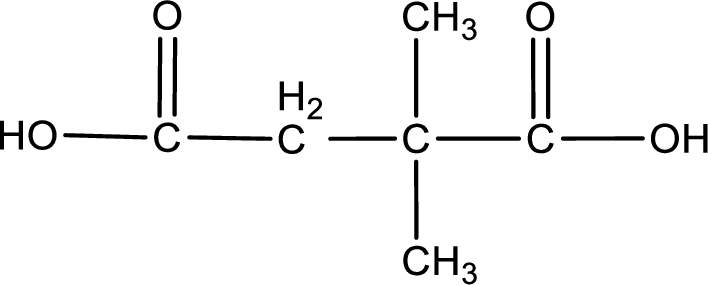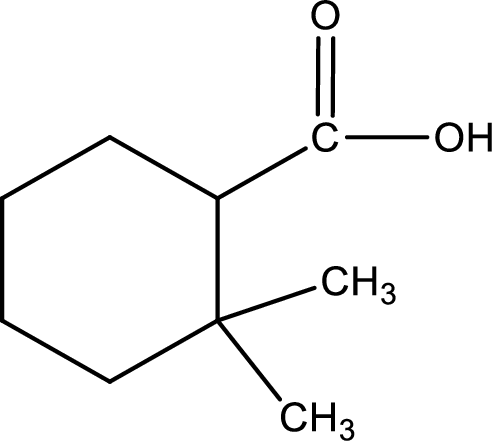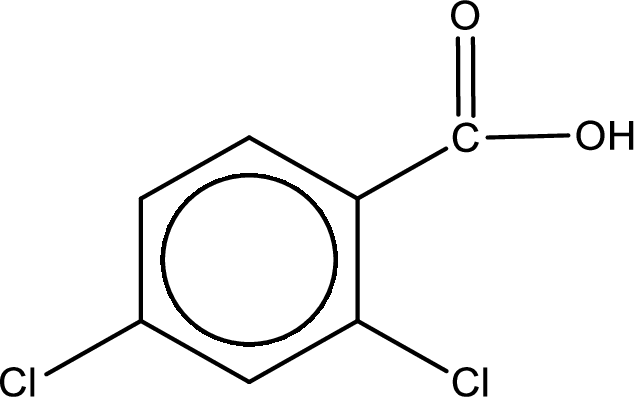
Concept explainers
(a)
Interpretation:
Condensed structural formula has to be drawn for the given
Concept Introduction:
The structural representation of organic compound can be done in 2D and 3D. In two-dimensional representation, there are four types of representation in which an organic compound can be drawn. They are,
- Expanded structural formula
- Condensed structural formula
- Skeletal structural formula
- Line-angle structural formula
Structural formula which shows all the atoms in a molecule along with all the bonds that is connecting the atoms present in the molecule is known as Expanded structural formula.
Structural formula in which grouping of atoms are done and in which the central atoms along with the other atoms are connected to them are treated as group is known as Condensed structural formula.
Structural formula that shows the bonding between carbon atoms alone in the molecule ignoring the hydrogen atoms being shown explicitly is known as Skeletal structural formula.
Structural formula where a line represent carbon‑carbon bond and the carbon atom is considered to be present in each point and the end of lines is known as Line-angle structural formula.

(a)
Answer to Problem 16.21EP
The condensed structural formula is,

Explanation of Solution
Given name of carboxylic acid is 2,2-dimethylbutanoic acid.
From the name it is identified that the parent carbon chain is butane and the substituent present in the chain are two methyl groups on second carbon atom. The first carbon atom is from the carboxyl group. The structure can be drawn as,

The condensed structural formula for the given carboxylic acid is drawn as shown above.
The condensed structural formula for the given carboxylic acid is drawn.
(b)
Interpretation:
Condensed structural formula has to be drawn for the given carboxylic acid.
Concept Introduction:
The structural representation of organic compound can be done in 2D and 3D. In two-dimensional representation, there are four types of representation in which an organic compound can be drawn. They are,
- Expanded structural formula
- Condensed structural formula
- Skeletal structural formula
- Line-angle structural formula
Structural formula which shows all the atoms in a molecule along with all the bonds that is connecting the atoms present in the molecule is known as Expanded structural formula.
Structural formula in which grouping of atoms are done and in which the central atoms along with the other atoms are connected to them are treated as group is known as Condensed structural formula.
Structural formula that shows the bonding between carbon atoms alone in the molecule ignoring the hydrogen atoms being shown explicitly is known as Skeletal structural formula.
Structural formula where a line represent carbon‑carbon bond and the carbon atom is considered to be present in each point and the end of lines is known as Line-angle structural formula.

(b)
Answer to Problem 16.21EP
The condensed structural formula is,

Explanation of Solution
Given name of carboxylic acid is 2,2-dimethylbutanedioic acid.
From the name it is identified that the parent carbon chain is butane and the substituent present in the chain are two methyl groups on second carbon atom. In the given name suffix “-dioic acid” is present. Therefore, this compound should have two carboxyl groups in it. The first carbon atom and fourth carbon is from the two carboxyl groups. The structure can be drawn as,

The condensed structural formula for the given carboxylic acid is drawn as shown above.
The condensed structural formula for the given carboxylic acid is drawn.
(c)
Interpretation:
Condensed structural formula has to be drawn for the given carboxylic acid.
Concept Introduction:
The structural representation of organic compound can be done in 2D and 3D. In two-dimensional representation, there are four types of representation in which an organic compound can be drawn. They are,
- Expanded structural formula
- Condensed structural formula
- Skeletal structural formula
- Line-angle structural formula
Structural formula which shows all the atoms in a molecule along with all the bonds that is connecting the atoms present in the molecule is known as Expanded structural formula.
Structural formula in which grouping of atoms are done and in which the central atoms along with the other atoms are connected to them are treated as group is known as Condensed structural formula.
Structural formula that shows the bonding between carbon atoms alone in the molecule ignoring the hydrogen atoms being shown explicitly is known as Skeletal structural formula.
Structural formula where a line represent carbon‑carbon bond and the carbon atom is considered to be present in each point and the end of lines is known as Line-angle structural formula.

(c)
Answer to Problem 16.21EP
The condensed structural formula is,

Explanation of Solution
Given name of carboxylic acid is 2,2-dimethylcyclohexanecarboxylic acid.
From the name it is identified that the parent carbon chain is cyclohexane and the substituent present in the chain are two methyl groups on second carbon atom. In the given name suffix “-carboxylic acid” is present. Therefore, this compound should have a carboxyl group attached to the cyclohexane ring. The carbon atom in the ring where the carboxyl group is attached is the first carbon atom. The structure can be drawn as,

The condensed structural formula for the given carboxylic acid is drawn as shown above.
The condensed structural formula for the given carboxylic acid is drawn.
(d)
Interpretation:
Condensed structural formula has to be drawn for the given carboxylic acid.
Concept Introduction:
The structural representation of organic compound can be done in 2D and 3D. In two-dimensional representation, there are four types of representation in which an organic compound can be drawn. They are,
- Expanded structural formula
- Condensed structural formula
- Skeletal structural formula
- Line-angle structural formula
Structural formula which shows all the atoms in a molecule along with all the bonds that is connecting the atoms present in the molecule is known as Expanded structural formula.
Structural formula in which grouping of atoms are done and in which the central atoms along with the other atoms are connected to them are treated as group is known as Condensed structural formula.
Structural formula that shows the bonding between carbon atoms alone in the molecule ignoring the hydrogen atoms being shown explicitly is known as Skeletal structural formula.
Structural formula where a line represent carbon‑carbon bond and the carbon atom is considered to be present in each point and the end of lines is known as Line-angle structural formula.

(d)
Answer to Problem 16.21EP
The condensed structural formula is,

Explanation of Solution
Given name of carboxylic acid is 2,4-dichlorobenzenecarboxylic acid.
From the name it is identified that the parent carbon chain is benzene and the substituent present in the chain are two chlorine atoms, each on second carbon atom and fourth carbon atom. In the given name suffix “-carboxylic acid” is present. Therefore, this compound should have a carboxyl group attached to the benzene ring. The carbon atom in the ring where the carboxyl group is attached is the first carbon atom. The structure can be drawn as,

The condensed structural formula for the given carboxylic acid is drawn as shown above.
The condensed structural formula for the given carboxylic acid is drawn.
Want to see more full solutions like this?
Chapter 16 Solutions
General, Organic, and Biological Chemistry
- List down five acidic commercially available products that contain organic compound/s Example Organic compoundarrow_forwardWhat are carboxylic acid? What is its general formula? What are the properties of carboxylic acid? What are the steps in the IUPAC and common naming of carboxylic acid? Draw 5 condensed structures of carboxylic acid and write their IUPAC name (do not include those in the video. What are the uses of carboxylic acid? Cite examples.arrow_forwardWhat kind of solvent ingredients is widely is usually used in mouthwash, perfumes and spray A. Ethly acetate B. Aliphatic alcohols C. Fragrant esters D. Phenols and phenol derivativesarrow_forward
- Explain why heat is needed in the hydrolysis of estersarrow_forwardWhat are the properties of carboxylic acid? What are the steps in the IUPAC and common naming of carboxylic acid?arrow_forwardBriefly explain the following. Why hydrolysis of esters produce a sour smell in some reactions? Why are alcohol solutions used in hydroxamic test for esters?arrow_forward
- Draw two examples of the compound described below: b. a 12-carbon molecule with carboxylate, diphosphate, and lactone (cyclic ester) groupsarrow_forwardshort explanation about tests for alcohols experimentarrow_forwardWhen treated with an acid catalyst, 4-hydroxybutanoic acid forms a cyclic ester (a lactone). Draw the structural formula of this lactone. Please also include the name, thanksarrow_forward
 General, Organic, and Biological ChemistryChemistryISBN:9781285853918Author:H. Stephen StokerPublisher:Cengage Learning
General, Organic, and Biological ChemistryChemistryISBN:9781285853918Author:H. Stephen StokerPublisher:Cengage Learning Organic And Biological ChemistryChemistryISBN:9781305081079Author:STOKER, H. Stephen (howard Stephen)Publisher:Cengage Learning,
Organic And Biological ChemistryChemistryISBN:9781305081079Author:STOKER, H. Stephen (howard Stephen)Publisher:Cengage Learning,
 World of Chemistry, 3rd editionChemistryISBN:9781133109655Author:Steven S. Zumdahl, Susan L. Zumdahl, Donald J. DeCostePublisher:Brooks / Cole / Cengage Learning
World of Chemistry, 3rd editionChemistryISBN:9781133109655Author:Steven S. Zumdahl, Susan L. Zumdahl, Donald J. DeCostePublisher:Brooks / Cole / Cengage Learning Chemistry for Today: General, Organic, and Bioche...ChemistryISBN:9781305960060Author:Spencer L. Seager, Michael R. Slabaugh, Maren S. HansenPublisher:Cengage Learning
Chemistry for Today: General, Organic, and Bioche...ChemistryISBN:9781305960060Author:Spencer L. Seager, Michael R. Slabaugh, Maren S. HansenPublisher:Cengage Learning Living By Chemistry: First Edition TextbookChemistryISBN:9781559539418Author:Angelica StacyPublisher:MAC HIGHER
Living By Chemistry: First Edition TextbookChemistryISBN:9781559539418Author:Angelica StacyPublisher:MAC HIGHER





